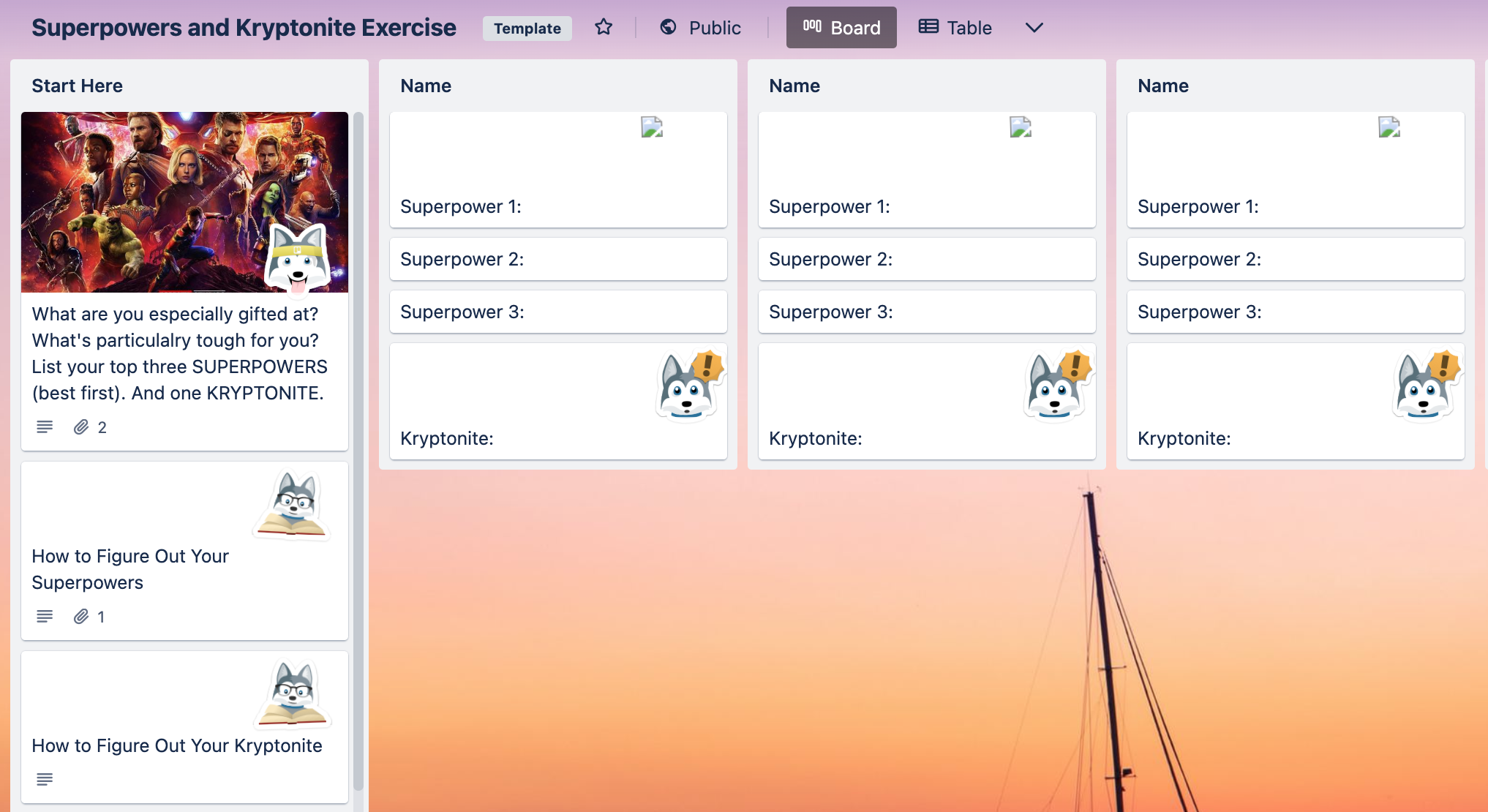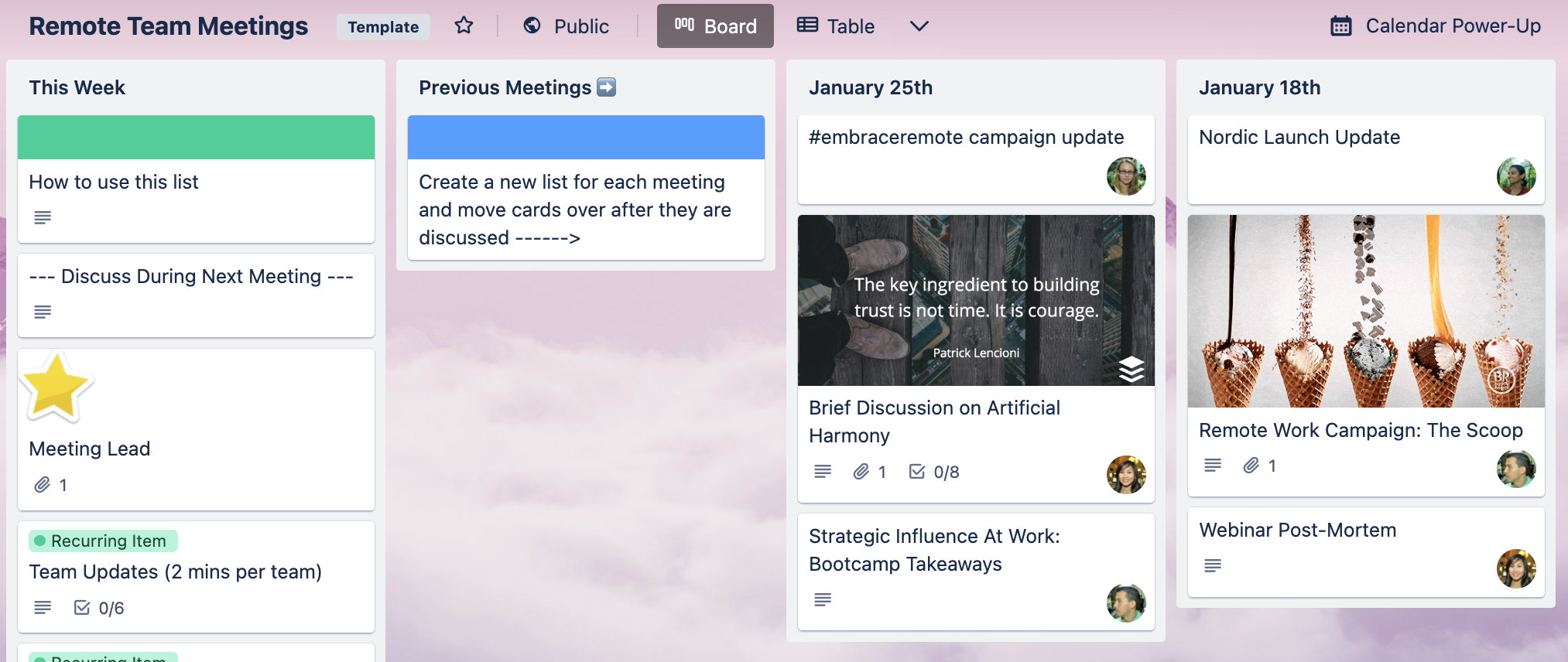Did you know that your team meetings can be a great opportunity to build psychological safety?
Why does that matter? It turns out that psychological safety is a key factor in boosting team performance. In a recent study published in the peer-reviewed journal Frontiers in Psychology, researchers stated the importance of psychological safety like this:
Psychological safety is the engine of performance, not the fuel.
People who feel psychologically safe at work are more willing to be vulnerable in terms of contributing ideas or pointing out potential problems. Because they have plenty of support and encouragement to speak up, these folks are more comfortable taking risks without fear of judgment, finger-pointing, or punishment.
Your team meetings are a frequent and reliable outlet to create a foundation of psychological safety by helping your team form strong bonds. When people have a chance to get to know each other on a more personal level and form a closer connection, they don’t only build familiarity—they build trust.
Curious about how to go about incorporating a few bonding opportunities into your team meetings—without trust falls, human knots, and random questions about desert islands? Look no further.
Team meeting ideas for new or new(ish) teams
Whether you have a group of long-standing colleagues starting a new project or a cross-functional team of people who don’t know each other all that well, these team meeting ideas will break the ice, loosen people up, and help them feel a little more comfortable before you get into the nuts and bolts of your meeting.
1. Ask a few non-cringey icebreaker questions
We get it—icebreaker questions can sometimes inspire some groans and eyerolls. But there are some creative ones you can ask to help everybody learn something new about each other. For example:
- Given the choice of anyone in the world, whom would you want as a dinner guest?
- For what in your life do you feel most grateful?
- If you could wake up tomorrow having gained any one quality or ability, what would it be?
- In the event of a zombie apocalypse, what three items would you grab from your home? (This is actually one of our favorites. Check out our Surviving the Apocalypse template if you want to do this icebreaker with a remote team.)
You could even ask team members to submit icebreaker questions ahead of your meetings so that they have some control over what they share and learn.
2. Do a quick show-and-tell
This game reignites your childhood enthusiasm and also helps team members find out more about what everyone values.
If you meet in-person, give team members a heads up that they should bring in an object to your next meeting and be prepared to explain what it is and why it’s important to them. This meeting idea works just as well (or maybe even better) remotely, when people can easily grab and showcase something from their own home.
3. Play “name that tune”
Nothing brings people together quite like music. In your next meeting, play the first few seconds of a couple of different tunes and challenge team members to name the song.
You could even set a theme for each week, like holiday songs or ’90s hits. Prepare for it to become a beloved team tradition that quite literally gets people moving in their chairs.
4. Switch up your introductions
Tired of meetings that start with the same old, “Tell us your name and what you do…”? Flip introductions on their head by having people introduce someone else in the group, rather than themselves.
You can pair people up (ideally, they should already know each other) or ask team members to volunteer to introduce someone else. It’s sure to be a far more interesting spiel—and likely filled with some glowing compliments the person never would’ve shared about themselves.
5. Share some photos
Personal photos give team members a more intimate glimpse at the lives of the people they work with.
Set a theme for each meeting—like your favorite vacation photo, your most embarrassing yearbook photo, or a photo of your pet—and challenge team members to share a relevant snapshot.
Team meeting ideas for motivation
Of course, your team meetings are about more than fun and games. When it’s time to get down to business, these team meeting ideas for motivation will inspire everybody to buckle down for a productive conversation.
6. Plan a thoughtful agenda
A worthwhile meeting starts before the actual meeting. Your agenda loops people in on what you’ll discuss so that they can come prepared with their best ideas and burning questions. Then you can use your meeting time for meaningful conversations rather than getting everybody up to speed.
Use a simple meeting agenda template to collaborate with your team and plan an intentional, organized, and actionable discussion.
7. Celebrate your wins
Kick off your meeting on a high note by using a few minutes to highlight recent wins and accomplishments—whether you call attention to them yourself or ask other people to chime in.
Not only does this set a positive tone, but it also gives motivation a boost. It’s called the progress principle, which states that “of all the things that can boost emotions, motivation, and perceptions during a workday, the single most important is making progress in meaningful work.”
8. Understand team priorities
If you want everybody to walk out of your team meeting with a clear idea of what they should focus on, try the 5 things workflow.
Joel Spolsky, co-founder of Trello, came up with this format. Every team member is asked to share five things—either directly in a meeting or on the Trello board:
- Two tasks they’re currently working on
- Two tasks they plan to work on next
- One task that people might expect them to be working on but they weren’t actually planning on doing
It’s a straightforward way to cut through the noise and understand exactly what everybody is (and should) be working on.
9. Encourage fidgeting
Think intense motivation means sitting still in your chair? Think again. Research shows that fidgeting can actually help people feel more calm, creative, and even more focused.
Bump up the motivation level in your meetings by giving people opportunities to use their hands—like putting small toys, trinkets, doodle pads, or even Play-Doh in the middle of the table. Have a remote team? Gifting everybody a branded fidget spinner could be a good surprise.
10. Keep a detailed history
It’s tough to feel motivated if every single meeting feels like Groundhog Day—like all you’re doing is constantly rehashing a previous conversation.
Prevent this repetitive feeling by setting up a weekly team meetings board. Not only will it help you plan a successful meeting, but it also has space for you to keep a log of all of your previous meetings. That means everybody can get the context of what’s already been discussed, so you don’t need to keep hitting the “replay” button.
Team meeting ideas for communication
For your meetings to be as positive and productive as possible, people need to know how to successfully interact with each other.
These team meeting ideas for communication can help your team members understand how to better relate to one another—and how to more effectively share their message.
11. Clarify roles
If your meetings currently involve a lot of toe-stepping, it’s time for you to clarify who’s responsible for what. The DACI framework requires that you categorize your team members by:
- Driver: Who’s leading the team, project, or decision
- Approver: Who has ultimate sign-off
- Contributors: Who is involved or chipping in
- Informed: Who needs to be kept in the loop
This straightforward system helps people understand where and how they fit in so they can communicate more effectively.
12. Identify your 4 L’s
Understanding and empathy are crucial for successful communication. The 4Ls retrospective asks team members to identify what they loved, loathed, learned, and longed for in a recent project, event, or sprint of work.
This exercise is a simple way to reflect back on your work together, get better insight into other peoples’ experiences, and improve as a team moving forward.
13. Create team user manuals
Personal user manuals are another effective way to increase understanding. This isn’t about a technical booklet to help you unjam the printer—these user manuals help team members understand what makes each other tick.
Use this template from Confluence to get started.
Everybody can fill out their own document, listing everything from their communication preferences to how they prefer to receive feedback.
Have everyone discuss their pages during a team meeting. Then, retain the pages on Confluence to create a handy reference for new teammates, as well as longtime coworkers.
14. Understand strengths and weaknesses
All of your team members are unique. Figuring out what everybody brings to the table helps build even more shared understanding.
With this Superpowers and Kryptonite exercise, each team member adds their name to the list. Then they write down two or three of their superpowers and one to three things that prevent them from performing their best. It’ll help them relate to the experiences of other team members and approach conversations with more empathy.
15. Run an experiment (or several)
The way your team communicates is as unique as your team members themselves. It might take you some trial and error to find the best ways to facilitate productive conversations—so it can be helpful to maintain an experimental mindset.
Maybe you’ll try asking everybody to close out Slack during your meeting time. Or perhaps you’ll test out a meeting where everybody needs to ask at least one question about an idea before providing any constructive criticism. When your meeting is done, send out a quick survey to find out if people thought it was more valuable. You might’ve landed on an idea worth repeating.
Team meeting ideas for Zoom
Nearly all of the above team meeting ideas can be used or adapted for video conference meetings.
But if you’re looking for some remote-specific suggestions, here are a few tips and exercises you could incorporate into existing meetings—as well as ideas for a few additional meetings that can help your distributed team connect even more.
16. Measure the mood
Remote meetings don’t always lend themselves to nonverbal cues, and it’s challenging to get a sense of how team members are feeling. Yet, our emotions provide important context, as research shows our emotions bias our perception.
There are simple ways you can get a feel for the overall mood of your team members ahead of a meeting, like asking them to share a GIF to describe their day or use an emoji reaction to summarize their current frame of mind.
Fun fact: The same part of our brain that processes human facial expressions also processes emojis.
17. Set up a collaborative space
Your remote team might not gather around a physical whiteboard, but they still need a centralized spot where they can plan meetings and work through conversations together.
This remote team meetings template brings focus and transparency to your team meetings with a collaborative approach (anybody can add cards to the “this week” list), a structured agenda, and helpful notes.
18. Encourage casual watercooler chat
Small talk might seem pointless on the surface, but that friendly chit-chat is exactly what helps your team members feel connected to one another. Unfortunately, that casual chatter often gets lost on remote teams.
At Trello, we set up specific Slack channels just for non-work chat. We also utilize Zoom to connect team members who may not know each other during a regular meeting we call “Mr. Rogers,” (yes, as in the TV show “Mr. Rogers’ Neighborhood”).
Want to try it? Use this watercooler video chat planner to regularly assign people to groups for an impromptu call where they can talk about anything they want. Groups can take a screenshot of their call and add comments about the random things they discussed so everybody can see what topics are bringing people together.
19. Unite distributed team members
You might not be able to walk past someone’s desk and see their recent vacation photo as their screensaver, but that doesn’t mean there’s no way for your team to share their travels.
The remote team bonding template offers a board where team members can add a card to highlight a recent excursion. They can share a photo and even offer some tips or must-see spots as a comment on the card. It helps unite your team, even if they’re spread across the globe.
20. Switch up locations
People probably have their default spots for your team meetings, but a change of scenery can help boost motivation and creativity. So, ahead of your next team chat, encourage everybody to sign in from a new place.
Whether they head out to a local coffee shop or soak in some afternoon sun on their own patio, that change can reignite their inspiration and give a fresh backdrop to your team Zoom calls. You could even ask people to share more about where they’re joining from, if they’re willing to.
Better meetings, better team
Your team meetings are your most frequent and regular chance to pull everybody together into one conversation. Don’t waste that opportunity on roll call and bland status updates.
Put these team meeting ideas into practice to build stronger bonds, boost motivation, and improve communication. You’re well on your way to not only better meetings, but a better team.
For more tips on how to have meetings that matter, check out “Trello’s Guide to Better Hybrid Meetings” from Atlassian Presents: Work Life.





















































